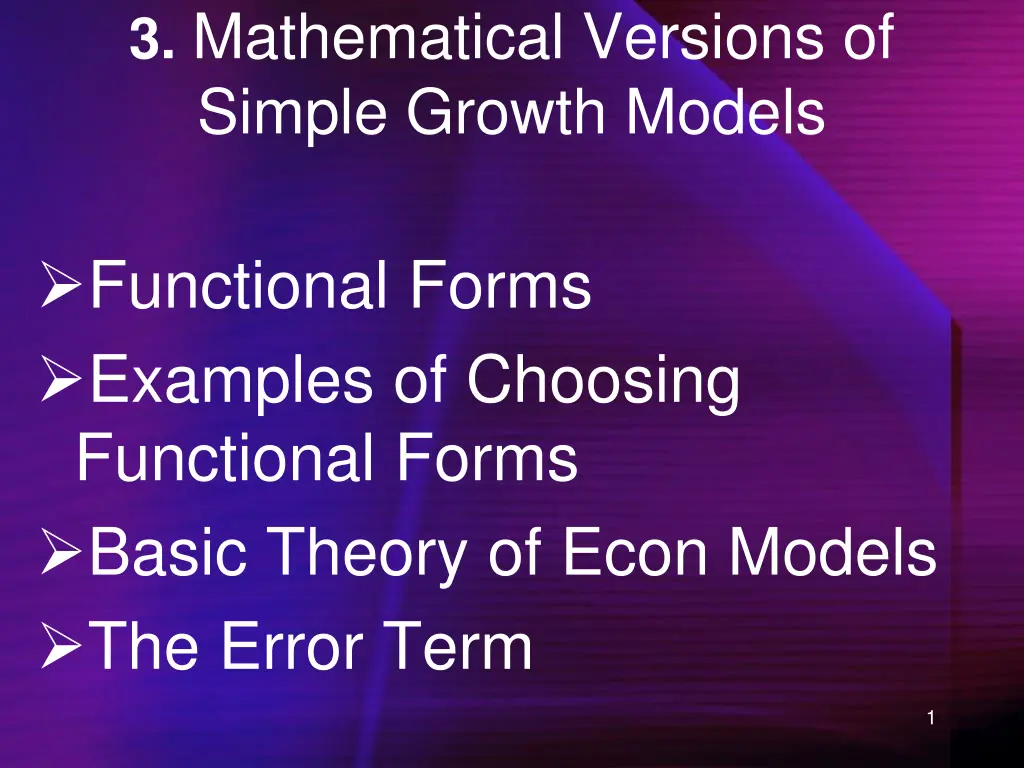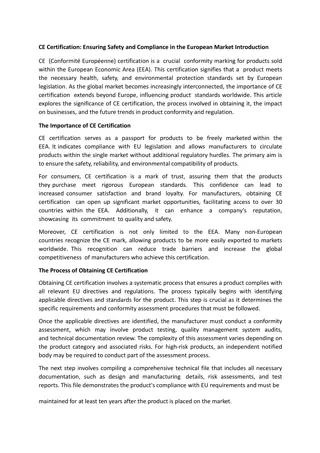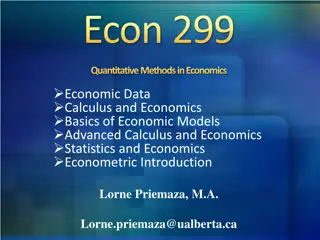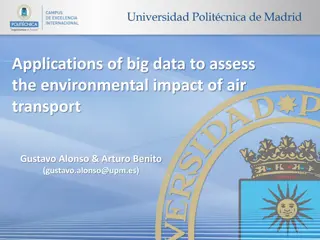
Understanding Functional Forms in Growth Models - Examples and Implications
Explore different functional forms in growth models, such as linear, exponential, and logarithmic, and understand how choosing the right form is crucial for accurate predictions. Discover the impact of various relationships between variables in the context of global warming.
Download Presentation

Please find below an Image/Link to download the presentation.
The content on the website is provided AS IS for your information and personal use only. It may not be sold, licensed, or shared on other websites without obtaining consent from the author. If you encounter any issues during the download, it is possible that the publisher has removed the file from their server.
You are allowed to download the files provided on this website for personal or commercial use, subject to the condition that they are used lawfully. All files are the property of their respective owners.
The content on the website is provided AS IS for your information and personal use only. It may not be sold, licensed, or shared on other websites without obtaining consent from the author.
E N D
Presentation Transcript
3. Mathematical Versions of Simple Growth Models Functional Forms Examples of Choosing Functional Forms Basic Theory of Econ Models The Error Term 1
3. Functional Forms To explain and predict the relationship between variables, it is ESSENTIAL to know the correct graph or functional form. The wrong functional form can lead to the wrong conclusion: 2
3. Global Warming and Functional Form When viewing historical data on temperature, most people assume a positive linear relationship (overlaid in blue) Source: BBC, http://www.bbc.co.uk/bitesize/higher/geography/physical/atmosphere/revision/2/ 3
3. Global Warming and Functional Form In his 2006 film, An Inconvenient Truth , Al Gore advocated a more exponential relationship: 4 Source: An Inconvenient Truth (2016) screen shot. Blue trend line added
3. Global Warming and Functional Form In laboratory settings, the pure greenhouse effect is seen to have a logarithmic relationship: 5 Source: Myhre et al (1988). Copied from http://www.moralcaseforfossilfuels.com/data/
3. Global Warming and Functional Form Other parties point out the historical cyclical nature of global temperatures: 6 Source: http://toadvancefreedom.com/climate-change-global-catastrophe-or-false-alarm/
3. Global Warming and Functional Form Different relationships between variables (different functional forms) can lead to different conclusions. THE FUNCTIONAL FORM MATTERS! 7
3.1.2.1 Linear Functional Form Linear: Yt= 1 + 2Xt Constant slope: 2 -straight line relationship -same increase every period ( 2>0) -same decrease every period ( 2<0) 8
3.1.2.1 Positive Linear Growth Linear Time Trend ( 2 >0): x=7+2t 25 20 15 x x 10 5 0 1 2 3 4 5 6 7 8 t 9
3.1.2.1 Negative Linear Growth Linear Time Trend ( 2 <0): x=250,000-10,000t 300000 250000 200000 150000 x x 100000 50000 0 1 2 3 4 5 6 7 8 t 10
3.1.2.1 Linear Growth Examples Positive Slope Examples: -Simple saving ($500/year, put into a matress) -Age: Starting age +1 every 365.25 days Negative Slope Example: -40 Day Christmas countdown 11
3.1.2.2 Quadratic Functional Form Quadratic : Yt= 1 + 2 Xt + 3 Xt2 Slope: Changing (see graphs) -U-shaped ( 3 >0) or inverted U ( 3 <0) -negative growth, then no growth, then positive OR -positive growth, then no growth, then negative 12
3.1.2.2 U-shaped Quadratic Model Quadratic Valley ( 3 >0): x=15-10t+t*t 10 5 0 x x 1 2 3 4 5 6 7 8 -5 -10 -15 t 13
3.1.2.2 Inverse U Quadratic Model Quadratic Hill ( 3 <0): x=15+10t-t*t 50 40 30 x x 20 10 0 1 2 3 4 5 6 7 8 t 14
3.1.2.2 Quadratic Model U-shaped Examples: -Introvert meeting someone new: less comfortable then more comfortable -Health care costs: highest after you are born and before you die Inverted U-shaped Examples: -Working out: increases health before decreasing it from overwork -Studying late at night: Improves mark before decreasing it 15
3.1.2.2 Lin-Log Functional Form Lin-Log: Yt= 1 + 2 *ln(Xt) Slope: Changing, positive or negative according to 2 -if 2 is positive, increases at a decreasing rate -if 2 is negative, decreases at a decreasing rate 16
3.1.2.2 Increasing Lin-Log Model Lin-Log Trend ( 2 >0): x=7+40ln(t) 100 80 60 x x 40 20 0 1 2 3 4 5 6 7 8 t 17
3.1.2.2 Decreasing Lin-Log Model Lin-Log Trend ( 2 <0): x=100-40ln(t) 120 100 80 60 x x 40 20 0 1 2 3 4 5 6 7 8 t 18
3.1.2.2 Reciprocal Functional Form Reciprocal: Yt= 1 + 2(1/Xt) Slope: Changing and tricky: -if 2 is negative, increases at a decreasing rate -if 2 is positive, decreasing at a decreasing rate -(sharper jumps than lin-log) 19
3.1.2.2 Reciprocal Model Reciprocal ( 2<0): x=50-8(1/t) 50 48 46 44 x x 42 40 38 1 2 3 4 5 6 7 8 t 20
3.1.2.2 Reciprocal Model Reciprocal ( 2>0): x=50+8(1/t) 60 58 56 54 x x 52 50 48 46 1 2 3 4 5 6 7 8 t 21
3.1.2.2 Log-log Functional Form Log-log: ln(Yt)= 1 + 2 ln(Xt) Slope: Changing, positive or negative according to 2 -shape depends on 2 (< or >1) -more gradual/smooth than lin-log or reciprocal 22
3.1.2.2 Increasing Log-log Model Log-log ( 2 >0): x=5+8ln(t) 25 20 15 x x 10 5 0 1 2 3 4 5 6 7 8 t 23
3.1.2.2 Slightly Increasing Log-log Model Log-log (0< 2 <1): x=5+1/20ln(t) 5.15 5.1 5.05 x x 5 4.95 4.9 1 2 3 4 5 6 7 8 t 24
3.1.2.2 Slightly Decreasing Log-log Model Log-log (-1< 2 <0): x=5-1/20ln(t) 5.05 5 4.95 x x 4.9 4.85 4.8 1 2 3 4 5 6 7 8 t 25
3.1.2.2 Decreasing Log-log Model Log-log ( 2 <-1): x=5-17ln(t) 10 5 0 -5 1 2 3 4 5 6 7 8 -10 x x -15 -20 -25 -30 -35 t 26
3.1.2.2 Positive Slope Model Examples: -Studying: each hour yields less as you approach perfect (diminishing marginal returns) -Pizza: Your enjoyment decreases after each piece (if enjoyment can become negative, u- shaped curve is appropriate) -Race Dilemma: Keep running of remaining distance to finishing line, never actually reaching it 27
3.1.2.2 Negative Slope Models Examples: -Drugs: fries a lot of brain cells to start, then when your whole brain is fried, few left to fry -Subsides: Large when you are poor, and small when you are rich -Earthquake: Each aftershock is less than the previous 28
3.1.2.2 Logistic Functional Form Logistic: = Y 1 2 2 3 + X ( ) e 1 2 1 -if all s are positive and 2 > 1, slanted-S shape -you can create or find a functional form to model any relationship 29
3.1.2.2 Logistic Model Logistic: = Y 1 2 2 3 + X ( ) e 1 2 1 Examples: Investing in undervalued stock. Little return, then huge increase (stock realized), then little return. 30
3.1.2.2 Cyclical Functional Form Cyclical: Y= 1 + 2 sin(2 X/p) + 3 cos(2 X/p) -alternating negative and positive growth 31
3.1.2.2 Cyclical Model Cyclical x=0+2sin(2pi*t/14)+2cos(2pi*t/14) 4 3 2 1 0 x x -1 1 3 5 7 9 11 13 15 17 19 -2 -3 -4 t 32
3.1.2.2 Cyclical Model Examples: Housing markets Tech markets Oil markets Yearly seasonal markets (fruit, ice cream, etc.) 33
3.2.1 Mathematical Models of Economic Relationships #1 Example 1 Consumption Function -consumption is based on income -even with zero income, some consumption (autonomous consumption) occurs -as income rises, consumption rises -out of every new dollar earned, a fraction, the marginal propensity to consume (mpc) is spent on consumption remainder is saved -the mpc determines the slope of the graph 34
3.2.1 Mathematical Models of Economic Relationships #1 constant slope/mpc is this realistic? Linear Consumption Function 700 600 Consumption 500 400 300 200 100 0 0 100 200 300 400 500 600 700 800 900 Income 35
3.2.1 Mathematical Models of Economic Relationships #1 decreasing slope/mpc is this realistic? Quadratic Consumption Function 2500 2000 1500 Consumption 1000 500 0 0 500 1000 1500 2000 2500 3000 3500 4000 4500 5000 36 Income (In $1,000)
3.2.1 Mathematical Models of Economic Relationships #1 Consumption Function slope = mpc Linear: Consumption = 100+0.5income mpc = slope = 0.5 (constant) Non-Linear Consumption = 100+0.95income-0.001income2 mpc = slope = (decreasing) Are any other functional forms viable for consumption? 37
3.2.2 Mathematical Models of Economic Relationships #2 Example 2 Short-run Phillips Curve -if no excess demand in the economy, the economy will be at the natural rate of unemployment -if unemployment falls, wages and prices will tend upwards (hard to find workers) -if unemployment rises, wages and prices will fall (easier to find workers) -these changes are asymmetric (excess labour demand has a bigger effect than excess labour supply) 38
3.2.2 Mathematical Models of Economic Relationships #2 Short-run Phillips Curve lin-log function Short-run Phillips Curve 6 5 4 3 Inflation 2 1 0 1 2 3 4 5 6 7 8 9 10 -1 -2 Unemployment 39
3.2.2 Mathematical Models of Economic Relationships #2 Example 2 Short-run Phillips Curve Slope = short-run response of inflation to a change in unemployment Inflation = 5 ln(unemployment) Slope: -as unemployment increases, the slope moves from very negative to slightly negative -there is a greater effect of low unemployment than high unemployment 40
3.2.3 Mathematical Models of Economic Relationships #3 Example 3 Demand for Xbox Gamma s -price of new game systems is often a hot topic -Xbox s sell for LESS than the Playstation -lose MORE money on system in order to make more money on more games -all else held equal, as price decreases, quantity demand increases -Xbox sacrificing gain on each system to sell more systems (and later sell more games) -downward sloping demand curve 41
3.2.2 Mathematical Models of Economic Relationships #3 Example 3 Linear demand for Xbox Gamma s Xbox Demand 6000000 5000000 Xbox Demand 4000000 3000000 2000000 1000000 0 0 100 200 300 400 500 600 700 800 900 Xbox Price 42
3.2.3 Xbox Math Note that while demand functions are generally of the form: = d Price Q 1 2 Since price is on the y-axis, to graph this function we need to solve for price: = 1 d Price 1 1 Q 2 2 But does a linear graph make the most sense? Will no one buy an expensive Xbox? Will someone say no to a free Xbox? 43
3.2.3 Mathematical Models of Economic Relationships Example 3 Lin-Log demand for Xbox Gamma s Xbox Demand 6000000 5000000 Xboxes Demanded 4000000 3000000 2000000 1000000 0 0 100 200 300 400 500 600 700 800 900 Xbox Price 44
3.2.5 Interpreting A Linear Function Yt= 1 + 2X Intercept = 1: The value of Y when X is zero Slope = 2: The change in Y when X increases by 1 Funt= 80 + 2Board Gamest Intercept =80. When there are no board games, fun is 80. Slope =2: When board games increase by 1, fun increases by 2. 45
3.2.5 Interpreting Any Equation Economists need to EXPLAIN MATHEMATICAL RELATIONSHIPS by explaining: 1) Intercepts 2) Slopes (first derivative) 3) Long-Run Effects (second derivative) 46
3.2.5 Simple Example Mark = 60 + 4 study Mark = percentage mark on midterm Study = hours of study (up to 10 it s the night before) Parameter Explanation: 1) 60 = intercept without studying, you d get a 60% on the exam - you genius you! 2) 4 = coefficient of study (first derivative) every extra hour spent studying increases your mark by 4% 47
3.2.5 Simple Example Mark = 60 + 4 study 3) D2mark/dstudy2=0, this function is a straight line; each hour of studying is equally beneficial 48
3.2.5 Another Demand Example Let q=100-p/2 Parameter Explanation: 1) The intercept (100) expresses the quantity demanded when the good is free (p=0) 2) The slope (-1/2) indicates how much q changes as p increases by 1. 3) The second derivative is zero, we have another straight line 49
3.3 The error term Although economists try to model real behavior, their attempts are not always 100% accurate, for a variety of valid reasons: 1)Excluded variables 2)Random events (shocks) 3)Error in data collection 50
















